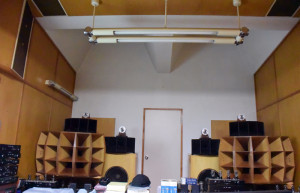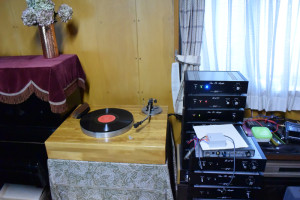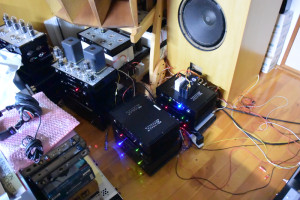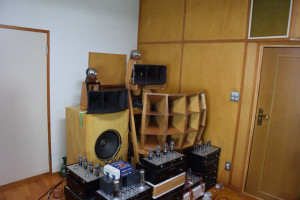”For the English , please kindly scroll this page down”
試聴会の翌日から、東北に出かけることになり、途中金田先生のお宅を訪問する機会が持てました。
ご存知の通り、先生のシステムは天井ホーンを低音に使用した、かなり大がかりの4wayシステムです。
聴かせて頂いた感想は、その見かけとは異なり、大変ナチュナルナ音であり、4wayすべてのチャンネルの音が全くの違和感が無く、空間合成され、まるでフルレンジの上下拡張な感じを受けました。主にJazzソースでしたが、音に弾みが有り、サックスソロでは、張り出す中音域が気持ちがいいです。軽やかな低音がまたリズムを心地よく刻みます。普段先生が聴いている音の確認ができまして、とても貴重な体験をすることが出来ました。
ご訪問を快く受け入れていて頂き、金田先生には感謝している。
先生の部屋は、ベースに石井 伸一郎先生(改訂増補 リスニングルームの音響学)の理論を採用しているそうだ。そして奇遇にも、先生宅訪問前日には、石井 伸一郎先生とご一緒に東北にいたのでした。金田先生のリスニングルームは、結構昔に作られたのだが、石井先生は当時、本や学界に発表しても日本ではほとんど反響は無かったんですよ(海外からは何件かの問い合わせと実際に建設が行われた)、なんてことを前日に聞いたばかりでもあり、こんな身近に理解がある方がいて灯台下暗しでありました。金田先生曰く、当時こんな明確、かつ理にかなうことを言われていたのは石井先生おひとりだと、大変高い評価をおしゃっています。
先生のシステムは固定的なアンプではなく、いつも最新式を使っているとのことです。新しく発表するアンプは必ず改善が有り、より良くなっていて、”最良の音で聴くには最新が良い”、と、シンプルな理論です。但し、4way4台のアンプを必ずしも作れるわけではないので、ある程度は組み合わせとなるようで、今回は下記のシステムになっていた。最新が一番良いととは言え、私には既に好みの範囲での違いのようにも思えるので、これで良いと思った。マルチアンプの成功への秘訣としては、すべて同じアンプで揃えることは必須条件であったが、左様な訳で組み合わせでもよろしいようだ。
・Technics SP10-MK1Turntable
・Roland R-44 PCM Record/Play
・pre-amp No236 403A Current transmission Phono equalizer
・D/A Converter 403A Current transmission D/A Converter
・No219 6dB/oct Current transmission 4Ch. Channel filter
・(High)No235 SCTMU001F Battery 396A Hybrid
・(Mid-High)No238 First-Stage Single-Tube Super Hybrid SCTMU001F
・(Mid-Low)No238 First-Stage Single-Tube Super Hybrid SCTMU001F
・(Low)No222(No228)SCTMU001F Battery but Battery volt 7.2V
Visiting Prof. Kaneta house.
————-
<NOTE>Mr. Kaneta had been a professor at a national university until his
retirement.
So, we still call him as Prof. Kaneta with respect.
—————
From the next day of trial listening meeting, I went to Tohoku (North-East Japan). And I had an opportunity to visit Prof. Kaneta house.
As you may know, his audio system is a large-scale 4-way system with using ceiling-mounted horn speaker for the bass sound.
In my impression, his system sounds were very natural unlike its appearance. Each 4-way channel is mixed in the space without any incongruity. And it was like the sounds of full range speaker extended upper and lower.
I listened jazz sources mainly at that time. It is vivid, and when sax-solo came in, I was soaked in the full of life mid-range sounds. Airy bass sounds beat out rhythm cozily along with it. It was very precious experience for me to know the sounds that he listened normally.
I appreciate him for willingly accepting my visit.
As I heard, he adopted Shinichirou Ishii-sensei’s theory (the author of “Acoustics of listening room revised and enlarged edition”) to his audio room base. And I was with the Shinichirou Ishii sensei unexpectedly in Tohoku the day before.
Prof. Kaneta’s listening room was built long before. And it reminded me a story I had just heard from Ishii sensei: When he presented his theory at an academic conference or by book, almost no one cared about it. (Some inquires were made from outside of Japan and some people adopted his theory and built listening room based on it)
The darkest place is under the candlestick should be the word for that because now I know Prof. Kaneta support his theory. And I did not know that until this time. Prof. Kaneta has a high opinion about him as he said that Ishii sensei was the only person who published on listening room acoustics clearly and rationally at that time.
<NOTE>
“Sensei” is a Japanese honorific title, which is used for the person who has a specialized knowledge.
Prof. Kaneta said he does not use fixed-amps but he always adopts new models. This is because of his simple logic that new amp should be the improved and better one, so “if we want to hear the best sound, we should use the most updated one.” But, it is difficult to create 4-way 4-same-amp environment at all time. So when it is impossible, we have to choose different amps to some extent as current his system is (shown below). Even though he said up-to-date amp is the best, I felt he mixes different amps in the range of his taste so I thought this is good. It has been considered that the necessary requirement to success multi-amp-system is to use same amp. But now I realize it is also good to choose different amps in a system.
・Technics SP10-MK1Turntable
・Roland R-44 PCM Record/Play
・pre-amp No236 403A Current transmission Phono equalizer
・D/A Converter 403A Current transmission D/A Converter
・No219 6dB/oct Current transmission 4Ch. Channel filter
・(High)No235 SCTMU001F Battery 396A Hybrid
・(Mid-High)No238 First-Stage Single-Tube Super Hybrid SCTMU001F
・(Mid-Low)No238 First-Stage Single-Tube Super Hybrid SCTMU001F
・(Low)No222(No228)SCTMU001F Battery but Battery volt 7.2V





